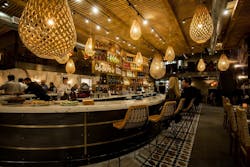Light Fixtures Focus on Safe Materials and Sustainable Practices
Legend states that New Zealand was originally founded by eight tribes who sailed from Polynesian islands in eight waka, or canoes, then landed and settled in different parts of the country.
Continuing this legend through interior design is John Cook, CEO and founder of wakaNINE, or what he likes to describe as the ninth waka. The company works to bring products from the other side of the world directly to North America.
Founded in 2009, wakaNINE distributes a range of uncommon lighting fixtures from faraway countries, including New Zealand, Thailand and South Africa. Cook doesn’t just partner with any lighting company, however. All of the brands he currently works with—including David Trubridge, TruK, FIRE+ICE, PLN Group and ANGO—focus on providing eco-friendly materials, originality, ethical manufacturing and sustainable production techniques.
Cook believes these traits are fundamental to both business and humanity, and shouldn’t be seen or used as a marketing spin.
Material Transparency Matters
“I initially thought the focus would be internet and technology, sheep or another primary industry, but I discovered interior design,” Cook says. “There was very little, if any, New Zealand design being imported into the U.S. and Canada.”
As of today, wakaNINE has supplied lighting designs to many commercial and residential projects across North America, including visible names like Starbucks, Lululemon, Macy’s, Amazon, Google and Microsoft. The company’s focus on material transparency and eco-friendliness are at the forefront of the health and wellness trend that continues to rise in the interiors industry.
“We’re trying to 100% understand what is in our products,” says Cook. All of the lights that wakaNINE distributes are comprised of recycled or sustainable materials, including:
- Bamboo plywood. David Trubridge’s range is a by-product from bamboo shoots.
- Diesel engine air filters, which are upcycled to create TruK’s fixtures, extending their use and removing them from landfills
- Recycled water bottles. A minimum of 65% post-consumer waste is used to create PLN Group’s HUSH acoustic fixtures.
- Recycled glass that’s formed into FIRE+ICE’s bespoke chandeliers.
- Silk cocoons, rattan and mulberry bark, the natural materials used in the ANGO range.
Cook adds that wakaNINE is continuously working to better its products and the materials that comprise them. “For example, HUSH’s material is in the Declare database, but HUSH as a product isn’t,” he notes. “We’re working toward getting PLN Group’s products to be Declare.”
[Podcast with wakaNINE: Decorative Fixtures Focus on Supporting Wellness and Sustainability]
Declare is a transparency platform that takes chemical and material source information and provides it to consumers in an easy-to-use nutrition label. Those in the architecture and design industry often use the Declare Database to make specification decisions for their projects.
If the fixtures were to be fully assembled at wakaNINE’s headquarters in Austin, TX, and shipped, the freight volume would be 10 times greater and the cost three times larger than for the semi-assembled versions.
(Photo: FIRE+ICE LIghting. Credit: FIRE+ICE.)
Plus, David Trubridge obtained an Environmental Product Declaration for the majority of his Seed System lights. Products that fall under this certification are third-party verified and earn points under green building rating systems like LEED.
Cook notes that David Trubridge was the first line wakaNINE worked with and was the only range he distributed for the company’s first six years, but has since expanded to include PLN Group (New Zealand), Ango (Thailand), along with TruK and FIRE+ICE (South Africa).
“While all the lines are unique and quite different aesthetically, there are some strong themes that connect them,” Cook states. Biophilic, sculptural, niche, and socially responsible are a few of the characteristics that he says link them together under wakaNINE.
The Future of Materials
(Photo: Coral 600 AL Black Shadows. Credit: David Trubridge.)
“Building materials and products are not only an integral part of our lives but, unlike most consumer goods, have a much longer use phase, making their chemical composition, and potential impact on indoor air quality, significant,” WELL notes on its website.
Technology is also getting involved in the specification process. Software solutions such as Toxnot are helping quicken the process of finding safer alternative material solutions, and enabling companies and manufacturers to submit Declare labels directly to the International Living Future Institute.
“It’s really just common sense when it comes to using safe materials,” Cook says. “Right now, it’s sort of like organic food was 10 to 15 years ago. It was a bit unknown and considered an expensive luxury. But now, it’s considered safe and is mainstream, and safe materials should be the same way.”
Read next: How Duvaltex Created the Industry’s First Biodegradable Polyester
About the Author

Adrian Schley
Associate Editor
Adrian Schley was an Associate Editor for i+s, where she covered the commercial interior design industry since 2018. Her work can also be found in BUILDINGS and Meetings Today.
